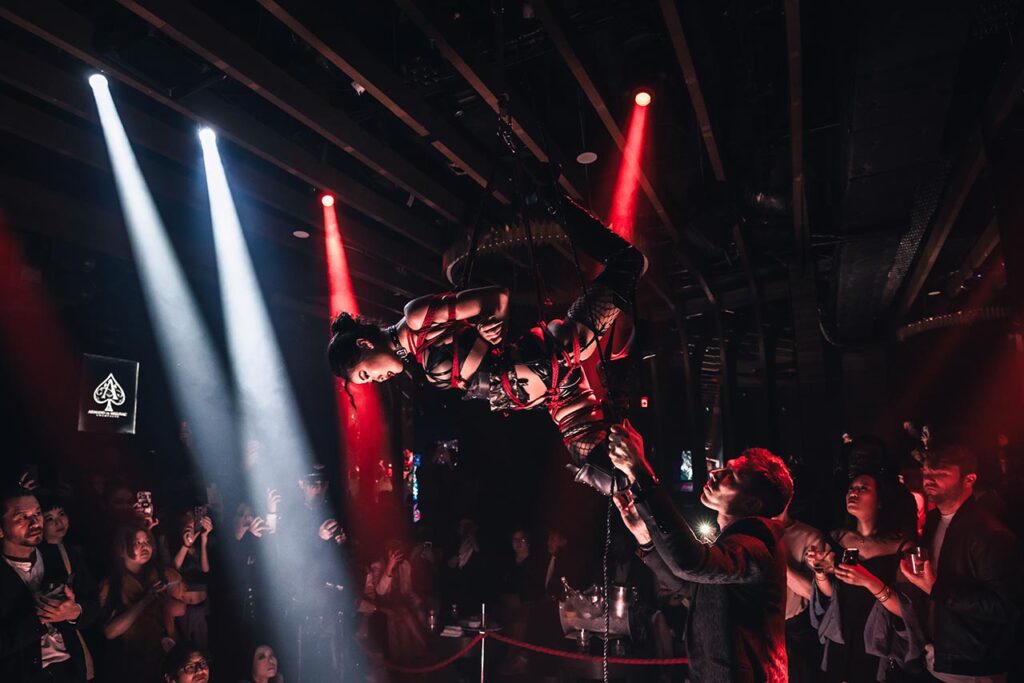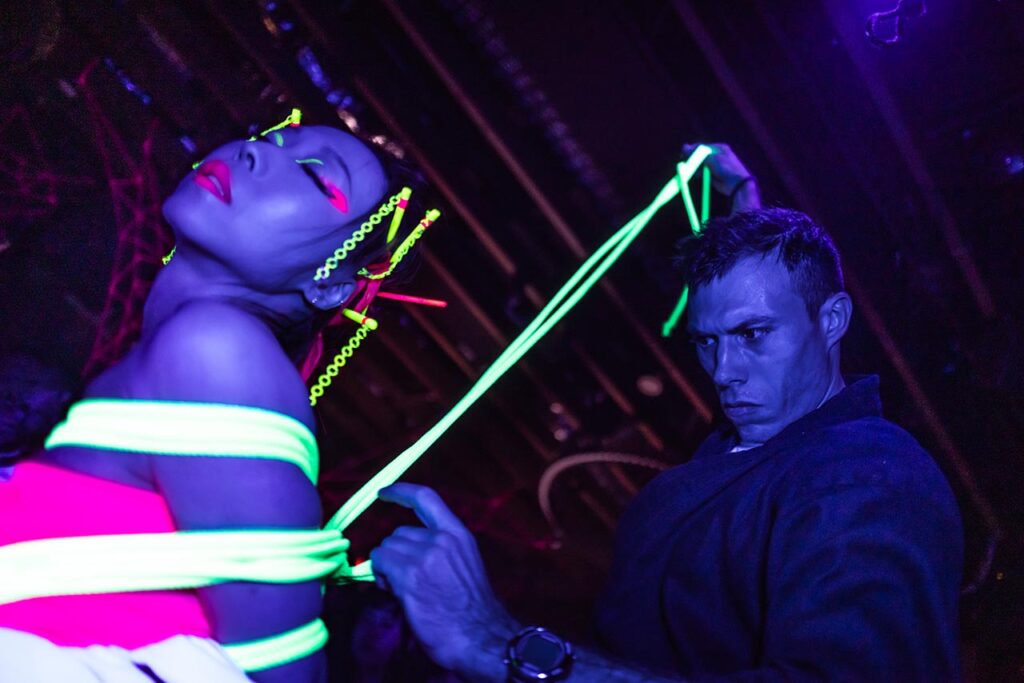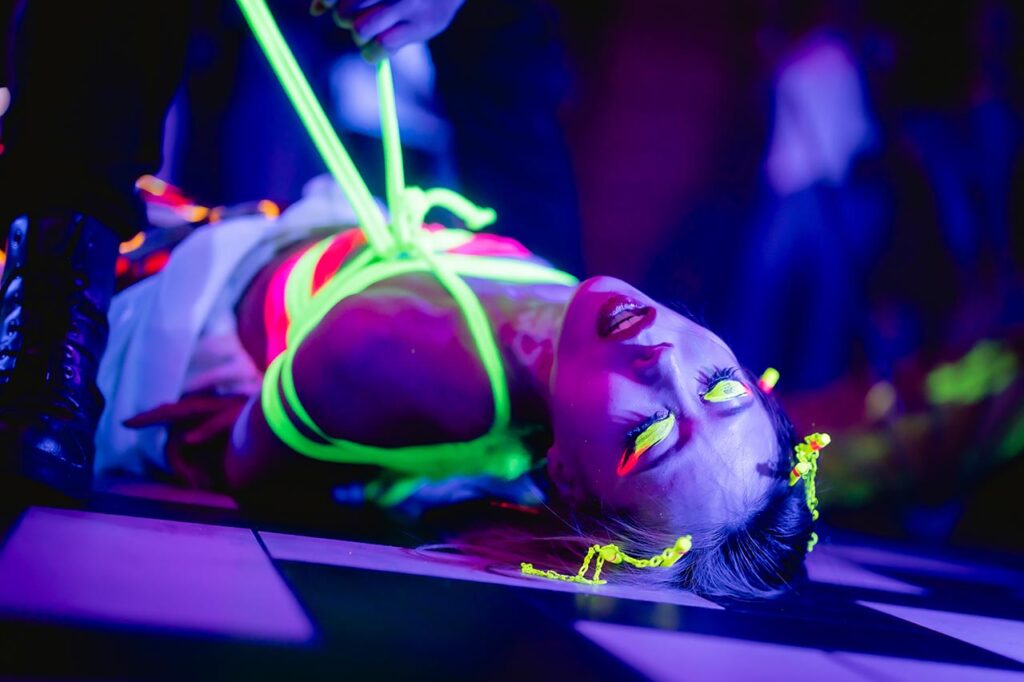
Tokyo, 14 février 2025
Shibari still sits between art and controversy in Japan’s nightlife. As a performer exploring its shift from underground to mainstream, I was happy to answer questions of Liza Glushak for Sighted Magazine with Bobby Pitts. In the below interview transcript we discuss the challenges of performing in clubs, the lingering stigma, and shibari’s evolving place in society, alongside photographer Bobby Pitts.

Words by Liza Glushak for Sight Magazine

When foreigners think of Japanese nightlife, the first to come to mind may be izakayas or clubs in social hubs like Shibuya or Roppongi. Little is known of the Japanese underground beyond what is posted by tourist guides due to the lack of publicity around slightly more risque nights. Shibari – Japanese rope bondage, is one such performance that has been establishing itself as a spectacle Tokyo night owls seek out. Booming in the 50s strictly as a sexual fantasy showcased in SM novels and later pornographic films, rope artists such as Louis Kordexe are giving it an artistic flair and drawing in new audiences, both Japanese and foreign. The conversation with Louis and photographer Bobby Pitts sheds light into what makes shibari performances exciting despite the lingering prejudices surrounding the art form.
Louis is a student of Hajime Kinoko, a shibari master who was the first to introduce shibari as a mainstream rope art that can be stageworthy in the 2010s. Louis discovered shibari through a personal relationship, but it soon became a career opportunity when his mastery with the rope was noticed at a fetish party, and he was persuaded to display his craft on stage.
Due to its history, shibari is still stigmatised amongst the Japanese and consequently not many mainstream clubs readily host shibari shows in fear of reputation damage. Nonetheless, he has now performed shibari at established clubs like 1OAK Tokyo, as well as intimate venues such as Studio La vie en Rose. He and his partner Kiyome incorporate the original Japanese bondage together with West inspired aesthetics, such as experimental lighting and electronic music to create a dynamic performance.
Bobby, who has photographed various shibari events, comments on the contrasting vibe unique to every shibari performance depending on the rope artist. Louis’s style consists of controlled movements and a fast pace, and without being explicitly sexual it remains sensual. Bobby explains that some artists prefer to specifically desexualise shibari in order to break the stereotype of vulgarity. Louis considers it important to ground his performances in the cultural origins of shibari respecting original ties and technique, while fusing it with his own French heritage and not completely removing the erotic component inherent to Shibari. He uses the word ‘panache’ to describe the stage style he aims at, which can be seen in his flamboyant rope colours, costumes, and lighting.

Q: What goes through your mind while performing shibari in clubs?
Louis: The main question is who do I tie for? In my opinion, this determines how I tie. There are three main ways I approach shibari: tying for my partner during play, tying for a picture, and tying for performance.
During a play, the partner is at the center of the tie, during a photoshoot the goal is the final picture, and with staged performances I tie for the audience. This defines at least three very different ways to approach shibari. Performance prioritises the safety of the model but not her pleasure – it’s about impressing the audience. To keep the audience engaged, speed is essential, together with fast transitions, impressive poses and beautiful staging. Of course while keeping the model’s safety as the priority.
The music, which is often techno, makes it necessary to think about the speed to stay aligned with the whole vibe of the moment. As a whole, stage performances require you to perfectly master what you do, especially in front of tens of recording cameras. I’m very concentrated while I’m on stage, and everything disappears in the moment aside from my partner. This is a very different mindset than during an intimate floor tie for example where the focus is on the partner’s pleasure, there is more room for approximation and no time pressure.
Q: Do you rehearse the routine beforehand?
Louis: I used to. Now I just make sure my partner is at ease with what we are likely to do, so we define a main pose and work around that at the moment. A lot of the time I don’t get to decide the music I perform to, so I end up improvising in the moment according to the BPM. Especially now that I’m more at ease on stage (Louis has done over sixty performances), I tend to improvise the performance more often. Sometimes I slow down the tying, but with techno music the style becomes more rough.
Q: There aren’t many photographers who work with shibari, so what made you confident it was something you were interested in?
Bobby: When I’m shooting I rarely have the space to admire or feel affected by the spectacle as I’m too focused on getting the angles and the composition, but I remember vividly that the first time I shot shibari I really was in awe. The chemistry between Louis and Kiyome was captivating.
Q: What effect do you think shibari has on the vibe of the club scene?
Bobby: I find that people in Tokyo are either all or nothing, and that applies to shibari too. Some will see it and feel embarrassed. They’ll turn their backs and ignore it completely. But those who are into it find it fascinating. They just stare and are completely engrossed by it.

Q: How could shibari ever become mainstream?
Louis: My view is that despite shibari being born in Japan, it is still very much stigmatized. I think that given the current trend it could be destigmatised if gains popularity in the West as a less sexualised and more mainstream practice. Then it might heal shibari’s reputation in Japan, but until that happens, the roots still leave many people thinking that its only place is in pornography or as a fetish. Time will tell.
Right now in Japan, although Japanese male shibari masters are the most visible, for example in the adult entertainment industry, a large majority of shibari practitioners in Japan are female dominatrixes who operate in the underground intimacy and privacy of the Japanese SM industry. They use shibari as one of their services (which does not include prostitution services) to satisfy mostly submissive male customers.
On the other hand, walking in the steps of Hajime Kinoko there are still not that many performers who bring it to the mainstream stage for the fun of the viewer. There’s not much shibari in the media, and some people even wear masks to go to events in order to stay anonymous. The event organisers also often allow pictures at the condition that no other customers are visible in the background. Even with tamed or removed eroticism in mainstream venues, privacy is still important. It’s still in its early years of becoming acknowledged as an art form, so maybe in ten years it will be more normalised like, for example, pole dancing has been. First we need to show to the world that it doesn’t have to be sexual and instead can just be a beautiful performance.
That said, a part of the shibari community thinks that shibari is not meant to be on stage, because tying for the audience inherently ignores the core of shibari which is about connecting with your partner in intimacy. I think this is true. Especially with a mainstream audience who is not necessarily educated about shibari and will not be able to read many subtleties, I sometimes take some shortcuts. But enjoying both sides of the coin, I don’t want to think of it as a conflictual approach with a right and a wrong way. I see it as the roots of shibari slowly giving birth to new branches sharing many things in their origins but with different purposes. Hence the question: “Who do I tie for?”

Q: How do performances affect the place of shibari in Japanese society?
Louis: Performances definitely help destigmatise shibari, and even if there is still resistance from society, it’s progressing. I want to show that it can just be something fun and beautiful, and by bringing in poses, suspension, lights etc. I try to bring attention to the beauty of the model in shibari.
See more
Words: Liza Glushak Instagram @verseforliza
Publisher: Sighted Magazine Instagram @sightedmagazine
Photographer: Bobby Pitts II on https://www.bpii-productions.com/ and Instagram @bpii_productions
↰ Back to Ressources and articles




